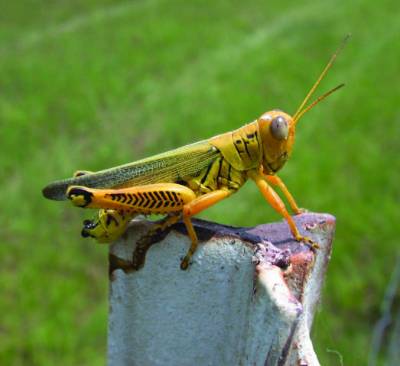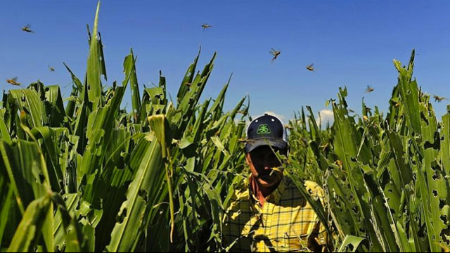Grasshoppers

There are over 100 species of grasshopper in Kansas, but luckily, there are only a few that cause damage to our home landscapes and gardens. Typically, grasshoppers are more of a problem for rural locations, but they can become a pest in urban gardens as well. Unfortunately, grasshoppers can be challenging to control because of their mobility, and one size doesn’t fit all when it comes to reducing the population.
When it comes to biology, not all grasshoppers are created equal, even though there are some similarities between species. Most species of grasshoppers will lay their eggs in the fall in non-crop locations such as ditches and fencerows in pods of 8-30 eggs. The eggs will hatch in the spring from April to June, depending on the grasshopper species and the soil temperature. From there, the eggs will go through five stages of growth over 35-50 days before becoming adults. Those first few days after the eggs hatch significantly affect how many grasshoppers survive. If there are adverse weather conditions or the right food isn’t available, many of the grasshoppers will die. Most species only have one lifecycle in a year, but the differences in how spring temperatures impact the hatching of eggs and the stages can lead to successive hatchings of eggs and make it seem like an endless hatch of new grasshoppers all summer. What makes grasshopper control hard is that a hungry grasshopper can fly for miles looking for new food sources, so while you may have killed the grasshoppers in your yard, they can easily come in from somewhere else.
When they see a grasshopper in their yard, the first thought in many gardeners' minds is to control the insects; however, paying attention to what the grasshopper is eating before treating it is important. Many grasshoppers only feed on grasses and sedges; some restrict their feeding to weeds, and some eat broadleaf plants we want to keep. In a garden setting, carrots, lettuce, corn, and beans are the most likely to be eaten, while tomatoes, squash (leaves), and peas are the least likely. If they aren't feeding on your plants, leave them alone. Pick plants that are not a preferred food by grasshoppers; Oklahoma State has an excellent list to reduce the likelihood they will munch on your flowers or provide a bait crop to keep the hopping insects happy and away from other plants. If a plant is susceptible to grasshopper damage and needs to be protected, use floating row covers over plants to exclude the pests. If the infestation warrants spray, use chemicals with the active ingredients carbaryl, cyfluthrin, or acephate (ornamental plants only). Pyrethrins work but only have a limited residual effectiveness on grasshoppers. You don't have to spray every plant in extensive areas for the chemical to be effective since the grasshoppers are mobile. You can usually get by with spraying only part (around 50%) of the plants to help control the insects. There are also grasshopper baits available on the market that can work for smaller areas but can be cost-prohibitive for large lawns or gardens.
is to control the insects; however, paying attention to what the grasshopper is eating before treating it is important. Many grasshoppers only feed on grasses and sedges; some restrict their feeding to weeds, and some eat broadleaf plants we want to keep. In a garden setting, carrots, lettuce, corn, and beans are the most likely to be eaten, while tomatoes, squash (leaves), and peas are the least likely. If they aren't feeding on your plants, leave them alone. Pick plants that are not a preferred food by grasshoppers; Oklahoma State has an excellent list to reduce the likelihood they will munch on your flowers or provide a bait crop to keep the hopping insects happy and away from other plants. If a plant is susceptible to grasshopper damage and needs to be protected, use floating row covers over plants to exclude the pests. If the infestation warrants spray, use chemicals with the active ingredients carbaryl, cyfluthrin, or acephate (ornamental plants only). Pyrethrins work but only have a limited residual effectiveness on grasshoppers. You don't have to spray every plant in extensive areas for the chemical to be effective since the grasshoppers are mobile. You can usually get by with spraying only part (around 50%) of the plants to help control the insects. There are also grasshopper baits available on the market that can work for smaller areas but can be cost-prohibitive for large lawns or gardens.
Grasshoppers will always be around and munching on plants, even in years when the population is lower. While they can be a pest, and the photo above gives me the heebie-jeebies, they are a valuable part of the ecosystem, providing food for birds, other insects, and, surprisingly, coyotes. Unless there is a significant infestation in your yard or garden, try providing bait crops, searching for egg-laying areas in the fall, or creating a yard where birds visit to help control these insects rather than resorting to sprays unless necessary.

Have questions? Contact our office where our Horticulture Extension Agent will assist you with questions.
Phone: (316) 321-9660
Email: callae@ksu.edu